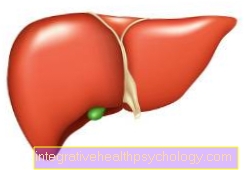How long does a fever last?
introduction
Fever is an increase in body temperature to 38 ° C or more. It is a measure of the body's own immune system to get rid of pathogens that cause disease. The duration of a fever depends on the underlying illness.

How long does a fever last?
The duration of a fever depends largely on the underlying disease. Sometimes the duration of the fever provides clues to possible causes of the disease.
If the fever lasts for two to three days, it is difficult to draw conclusions about the cause of the fever. In this case, the accompanying complaints are essential to making a diagnosis. Pneumonia or a cold are possible.
If the fever lasts for more than five to seven days, the fever curve can be better interpreted. With rubella, a rash occurs on the first day of the fever, with Schlarlach in the first three days. With measles, a rash typically occurs on the fourth to fifth day of fever.
In the case of salmonella disease, chronic inflammation of the liver and biliary tract or Pfeiffer's glandular fever, the fever lasts for more than two weeks.
Fever can even last for months. Months of fever occur in diseases such as familial Mediterranean fever or other febrile syndromes such as inflammation of the prostate or epididymis.
This means that there are various causes for the development of fever and depending on the cause, fever can last for a few days to months.
Read more on the topic: Familial Mediterranean fever
What factors affect the duration of a fever?
Fever is caused by a setpoint shift in body temperature in the hypothalamus of our brain. Bacteria and their poisons (toxins) activate the immune defense. The breakdown products of the body's own cells cause the release of messenger substances, the prostaglandins.
Prostaglandins play an important role in the development and duration of fever, as they lead to a shift in the setpoint in the hypothalamus. The occurrence and amount of bacteria and toxins, endogenous breakdown products and prostaglandins influence the duration of a fever.
Stress, age, health and metabolism also play a role in the duration of a fever.
What can I do to reduce the duration of the fever?
If you have a fever, bed rest is one of the most important home remedies. Stress should be avoided to shorten the duration of a fever. Physically strenuous activities such as sports and heavy lifting should be avoided.
When you're sick, you need a lot of sleep and rest. A healthy lifestyle and a balanced diet have a positive effect on health and ailments such as fever.
One can reduce the duration of a fever by taking antipyretic drugs. Paracetamol inhibits the formation of prostaglandins and is effective against fever. The agent acetylsalicylic acid (Aspirin®) intervenes in the formation of prostaglandins via a different mechanism and has an antipyretic effect (lowers fever). In addition, home remedies such as leg compresses, hot tea and apple cider vinegar counteract the fever.
Do you have any further questions about antipyretic measures? Read more about this on the following page: How can you lower a fever ?, Home remedies for a fever
Duration of fever after vaccination in baby
Vaccinations are recommended for babies to protect the children from harmful pathogens. The vaccines are generally well tolerated. However, physical reactions can occur, especially after multiple vaccinations or life vaccines.
In addition to an inflammatory reaction at the injection site with redness, swelling and pain, fever can occur. If the baby develops a fever after a vaccination, it usually subsides after a few days.
Paracetamol suppositories are suitable for babies to lower the fever. If the fever persists for more than a few days, you should see your pediatrician and have your baby checked for other causes of the fever.
For more information on fever in toddlers, see the following page: Fever in the toddler
Duration of fever while teething
Teething in children can be accompanied by an increased body temperature or a fever. The fever should subside after a few days. If the fever lasts longer, you should consult the pediatrician to rule out an infection as the cause of the fever.
You can find detailed information on this topic at Fever when teething.
Duration of a rheumatic fever
Rheumatic fever is an autoimmune reaction that can occur a few weeks after a bacterial infection. Rheumatic fever causes various symptoms, often inflammation of the joints, skin and heart. Even if the disease is called rheumatic fever, that does not mean that there is an obligatory fever. Fever can be a symptom of rheumatic fever, but does not have to occur. The fever can last for different lengths of time and depends largely on the course of the disease and the therapy.
Read more on the topic: Rheumatic fever
Duration of fever in brochitis
Acute bronchitis is an inflammation of the mucous membranes in the bronchi of the lungs. Viruses are often responsible for the disease and cause symptoms such as coughing with sputum and fever. Without treatment, most of the symptoms disappear in a healthy person after two weeks at the latest, while the dry cough often lasts longer. The fever can get high with bronchitis, but it shouldn't last more than a week. If there are comorbidities, an immune deficiency or other risk factors such as old age, the fever can last longer. High fever should be reduced with anti-fever medication as part of acute bronchitis.
For more information, see Duration of bronchitis.
Duration of fever with a viral infection
Fever is often associated with viral infections. It usually subsides after a few days.
For example, the flu is a common viral infection that is accompanied by a fever. There are also numerous different viruses that cause fever, among other things.
Fever can also occur with pneumonia caused by viruses. Infection with the mumps virus can also lead to elevated temperatures.
In the case of a viral infection, the duration of the fever depends on the form of the disease and the general health of the person affected. There are various forms of viral infections that are associated with elevated temperatures and fever, with the fever lasting different lengths of time.
If you have a viral infection, you may have a fever despite taking antibiotics. Read more about this at: Fever despite antibiotics - what to do?
Duration of fever with influenza
The real flu (influenza) is a serious virus-related infectious disease with inflammation of the airways, tiredness, fatigue and fever. Temperatures between 38.5 and 40 ° C are characteristic of influenza.
In an otherwise healthy person, the flu lasts for about 7 to 10 days, while the fever usually lasts from the 3rd to the 5th day. When the fever starts and how long it actually lasts depends on the state of health and risk groups.
The duration of the fever can be longer with the flu if people are chronically ill and / or have a weakened immune system.
A second infection with bacteria, a complex course of the disease and risk groups, i.e. children and old, weak people, can also lead to a long-lasting fever as part of the flu.
You can also find detailed information under Duration of the flu.
Duration of the fever with pneumonia
Pneumonia is often associated with difficulty breathing, chills, and fever. Body temperature rises rapidly, especially in the case of pneumonia caused by bacteria.
The fever can easily reach 40 ° C. Without antibiotic therapy, body temperature drops by the end of the first week of illness.
The fever can last longer than a week if complications of pneumonia occur. With concomitant diseases, old age and an immune deficiency, the fever can last longer and urgently requires drug therapy.
Read more about this under Duration of pneumonia.
Duration of fever with a cold
A cold (flu-like infection) causes a cough, runny nose, hoarseness, headache and body aches. In contrast to the flu, the symptoms of a cold appear insidious and the high fever typical of the flu usually remains away.
Nevertheless, temperatures above 38.5 ° C occur with colds. The fever is usually harmless and ends with the cold, that is after about three to seven days.
In healthy people, a cold is overcome after two weeks at the latest. In the case of complications, immunodeficiency or concomitant diseases, the fever can last longer than a week if you have a cold.
For more information, also read: Duration of a cold
Duration of the fever with tonsillitis
Inflammation of the tonsils (tonsillitis) often causes a fever. Adults are less likely to have a fever than children with tonsillitis. If tonsillitis is treated correctly, the symptoms subside after a few days. This means that the fever should have subsided after a week. If it persists, investigate whether there is another cause of the body temperature.
Read about this too Duration of tonsillitis.

























.jpg)



